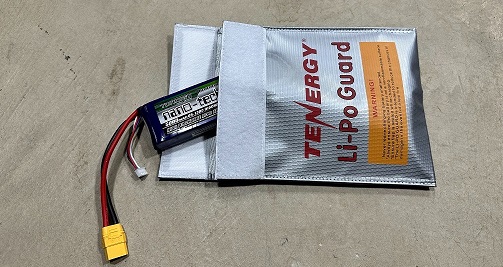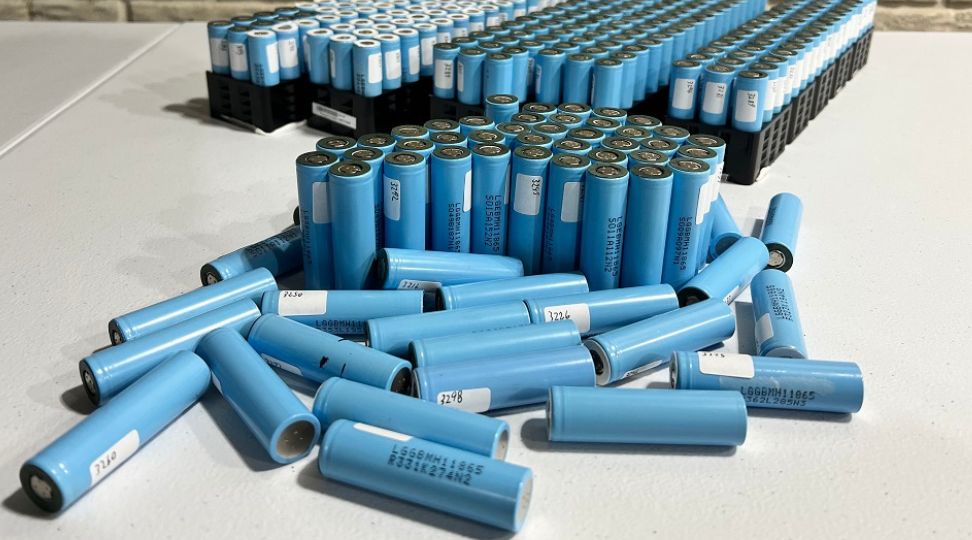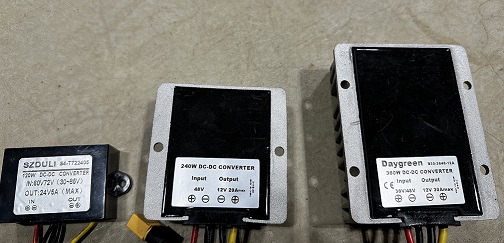
Best Voltages For Storing Lithium Batteries
Table of Contents
Properly storing lithium-ion batteries isn’t that difficult, there are just some key things that you need to know. If you don’t store batteries properly, they can lose capacity, become damaged, or in extreme cases, even start a fire. To keep your batteries in the best condition and to make sure they are gonna work when you need them to, the proper battery storage methods need to be employed.
To properly store lithium-ion batteries, make sure to remove them from any device they may be in, because keeping them installed can drain the batteries due to the device's small, but still inevitable standby current. Aim to store the battery at around 60-70% of its rated capacity. If possible, use a fireproof safety bag or container and always protect the cell terminals with tape or another electrically insulative material. Store batteries in a well-ventilated and dry area at room temperature or below, but not too cold.
The best storage voltage for lithium iron phosphate (LFP) cells is between 3.2-3.4V per cell, while for nickel-manganese-cobalt (NMC) cells, it's between 3.6V and 3.8V per cell. The best storage voltage for lithium titanate oxide (LTO) cells is between 2.4V and 2.5V per cell, and for lead acid batteries, it's around 2 volts per cell or 12 volts for a typical battery.
Ideally, you should have a designated area that you use solely for lithium-ion battery storage. This ensures that the batteries are kept away from heat sources and anything that can ignite. It also makes it so that the batteries are not left unattended in high-traffic areas where they can be damaged by someone. As far as what they are stored on, a non-flammable surface like concrete, metal, or ceramic is best. Avoid storing batteries in direct contact, avoid putting batteries in direct contact with one another, and of course, always have a fire detector in the storage area.
In this article, we will go over all the key aspects of properly storing lithium-ion batteries. We will tell you some dos and don'ts, and go over best practices.
Tips For Properly Storing Lithium Ion Batteries
While there is no for-sure way to totally prevent damage or accidents regarding the storage of lithium-ion batteries, there are some things you can do to drastically reduce the chances of an incident. If you follow the tips below, the battery packs or cells that you are storing will retain the maximum possible health during their storage tenure.
Don’t Store Batteries Fully Charged
The best storage voltage for lithium-ion batteries should be stored at whatever voltage is required to be at around 60-70% of its maximum charge voltage when not in use. This varies from cell type to cell type, but either way, the point is to avoid storing lithium-ion cells fully charged because the higher voltage range of a cell is where the chemistry inside is most reactive.
Don’t Store Batteries Too Drained, Either
Storing a battery at too low of a voltage won’t pose any danger or safety concerns, but it will hurt the batteries. If you begin a storage cycle with a voltage that is too low, then self-discharge could lower the voltage below 2.5V per cell, which irreversibly damages a lithium-ion battery.
There was a study on the aging of Lithium-Ion Batteries in Electric Vehicles, which examined Panasonic NCR18650PD NMC cells. The paper showed that storing the cells at 3.45V resulted in less degradation than at 3.7V, but at 3.45V, the remaining capacity is around 1%.
Place Inactive Batteries in Designated Storage Areas
Never, ever store lithium-ion batteries in unattended but open places. It’s perfectly fine to leave them alone and locked up somewhere, but don’t leave them alone in a high-traffic area unless you are always one of the people in that area.
Remove Batteries from Devices Before Storing
Another important thing to consider is that leaving the batteries installed will cause their voltage to drop much faster than their self-discharge rate. Eventually, a device’s standby current may pull the battery voltage down to 0 volts, damaging the cell.
Use Fireproof Safety Bags or Containers for Storage
This is a big ask, but really, if at all possible, store your lithium-ion batteries in a fireproof safety bag or some other fire-resistance container. These things help prevent catastrophic battery issues that may happen from spreading throughout the rest of your home or business.
They also provide an extra layer of physical protection against any external forces that could cause a short circuit and other hazards. 
Do. Not. Store. Batteries. In. Refrigerators.
And please, don't store lithium batteries in a refrigerator. The cold temperature will cause condensation to form when the battery returns to room temperature, this can damage the battery and make it dangerous to operate and even short it out to a degree. Yes, the fridge is a very cool, very dry place, but it's a bit too much in this case.
In fact, the extremely cold temperature can even make a battery brittle, which makes it more susceptible to cracks. So really, just don’t do this.
Install a Smoke And Fire Detector in the Storage Area
This one is a must. A smoke alarm is definitely more of an abortive thing rather than a preventative thing, but the thing is, if a house fire were ever to occur, it would be something you want to abort. Also, a really good smoke detector can even provide early detection and help prevent an all-out fire in your home or office.
Keep a Fire Extinguisher Near the Storage Area
This one is another must. For lithium-ion battery fires, a Class D fire extinguisher is the best choice, as it's designed to handle combustible metal fires, like lithium. These extinguishers contain a dry powder agent that smothers the fire and absorbs heat, effectively neutralizing the burning lithium.
Using a regular fire extinguisher, like a Class A, B, or C, is not recommended for lithium-ion fires, as they contain water or foam, which can make the fire worse. Instead, make sure to use a Class D fire extinguisher or some other type that uses dry sand or other non-reactive extinguishing agents.
Storing Lithium-ion Batteries in the Garage
The garage is a common storage location for lithium-ion batteries, which are frequently found in power tools. However, garages might not always be the best place for these batteries, as they require specific care.
Storing batteries in a detached garage can be problematic, particularly in cold climates. Detached garages often lack temperature control, exposing batteries to freezing temperatures or extreme heat, which can damage them.
Best Storage Voltage For LFP
Now that you know that a lithium-ion battery needs to be stored at about 40% of its maximum capacity, we can do a little math to find out the best storage voltage for LFP cells. LiFePo4 cells have a max charge voltage of 3.65 volts. Whatever you do, don’t do this:
3.65 volts x 0.40 = 1.46 volts
Because doing that assumes that the voltage curve is linear, it’s not. Storing LFP cells at 2.37 volts per cell would result in the cells being undervolted if they are stored for an extended period of time. So, considering the 3.2-volt nominal voltage of LFP cells, we recommend storing them just above that.
3.2 volts x 1.05 = 3.36V
So, for LFP cells, the best storage voltage will be between 3.2V and 3.4V per cell. Storing your LFP cells at this voltage will ensure that the cells are not left in their most active region, but also that they won't self-discharge to the point of damage over a longer storage period.
Best Storage Voltage For NMC
NMC cells have a higher max charge voltage of 4.2 volts per cell. So, the best storage voltage for NMC cells is going to be a little higher than for LFP. To store NMC cells for an extended period of time, it’s best to store them at a starting voltage that is just over nominal. This will ensure that they are not in their most reactive state and also not totally dead. So, an easy way to do this is to simply multiply the nominal voltage by around 1.05.
3.6 volts x 1.05 = 3.78 volts
Anywhere between 3.6V and 3.8V will be just fine. Storing NMC cells within this range will ensure that they are not stored in the voltage region that will cause self-discharge damage to the cell. It also will help give your cells a decent buffer so that their own natural internal self-discharge doesn’t completely drain them.
It’s important to note that whether it's a canister cell such as a 18650 or 21700, or a pouch cell (LiPo), the best storage voltage is the same.
Best Storage Voltage For LTO
LTO cells have a higher max charge voltage of 2.9 volts per cell, but they also have a lower nominal voltage of 2.3 volts per cell. So, going on the same logic as above, simply add 5 or 10 percent to the nominal voltage.
2.3 volts x 1.05 = 2.4 volts
This means that the best storage voltage for LTO cells is between 2.4 volts and 2.5 volts per cell.
Best Storage Voltage For Lead Acid
Storing lead acid batteries at too low of a voltage can cause sulfation, which can damage the battery's plates. On the flip side, if you store them at too high of a voltage, it will cause water loss and plate corrosion.
Lead acid batteries are super sensitive to over-discharge. This is why for every 100Ah in a lead acid battery, you can really only use 50Ah.
So, because of this, it’s best to store lead acid batteries at around 2 volts per cell. For most lead acid batteries which are composed of 6 lead acid cells in series, this will be around 12 volts. Any lower than that, and you will start to get issues over the long term.
For this type of battery, it’s best to periodically charge them or keep them on some sort of maintenance-level float charge.
Best Storage Voltage For NiMH
NiMh cells are a little different. They have a rated nominal voltage of 1.2 volts per cell. This type of cell is considered dead at around 1.0 volts per cell.
While it is true that these types of cells have a lower max charge voltage and are more resistant to damages incurred at the top end of their cycles, it is recommended to store these cells in a completely discharged state.
This type of battery has a memory effect and other limitations. So it’s good if you cycle these batteries around once per month while they are in storage. When you are ready to pull them out of storage, it’s good to put them through a full cycle before putting them back into active use.
Conclusion
When it comes to storing lithium-ion batteries at the best voltages, there are a few things that you need to remember.
Remove the lithium-ion battery from a device before storing it, and make sure to store the battery at 60-70% of the pack’s rated capacity, with a voltage of around 3.6V. Use a lithium-ion battery fireproof safety bag or another fireproof container when storing batteries and protect cell terminals with electrically insulating material. Store batteries in a dry and well-ventilated place at room temperature or lower.
To ensure the optimal storage of different types of batteries, specific voltage ranges need to be maintained. For instance, the best storage voltage range for LFP cells is 3.2V to 3.4V per cell, while NMC cells require a range between 3.6V and 3.8V per cell. Similarly, LTO cells should be stored within 2.4V to 2.5V per cell, and lead acid batteries require about 3 volts per cell or 12 volts for a typical battery.
Ideally, you would want to have a reserved area ONLY for lithium-ion battery storage, away from heat sources and any materials which can catch fire. The ideal surface for storing lithium-ion batteries is concrete, metal, ceramic, or any non-flammable material. Make sure that you are not storing batteries in direct contact with each other and always ensure that you’ve got a fire detector in the storage area. Another thing to remember is to never leave batteries unattended in high-traffic areas where they can be damaged by someone.
We hope this article helped you learn about the best battery storage voltage and how to best store lithium-ion batteries. Thanks for reading!



